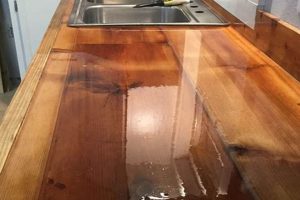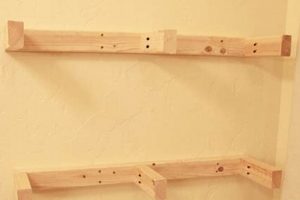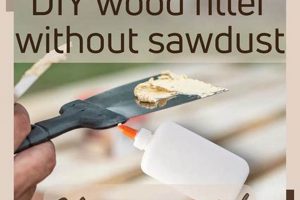Handcrafted gifts, particularly those constructed from wood, offer a personalized avenue for expressing appreciation on Father’s Day. The projects, often diminutive in scale, are intended to be crafted by individuals at home, typically requiring basic tools and readily available materials. These undertakings present an opportunity to create a unique item, such as a personalized photo frame, a small desk organizer, or a decorative wooden sign.
The significance of such endeavors lies in the tangible demonstration of effort and thoughtfulness. Unlike store-bought presents, these items possess sentimental value derived from the maker’s personal investment. Historically, handmade gifts have been valued as expressions of affection and skill, reflecting a deeper connection between the giver and recipient. Furthermore, these projects encourage creativity, resourcefulness, and can be a satisfying activity for families to undertake together.
This discussion will now focus on specific design ideas, construction techniques, and finishing methods relevant to creating personalized presents for Father’s Day, concentrating on those which can be accomplished with minimal experience and resources.
Tips for Crafting Wooden Father’s Day Gifts
Successfully executing small-scale, handcrafted wooden presents for Father’s Day necessitates careful planning and precise execution. These tips provide guidance for achieving optimal results.
Tip 1: Material Selection: Employ readily available, inexpensive softwoods such as pine or basswood for ease of workability. Consider reclaimed wood to minimize material costs and promote sustainability. Ensure the wood is dry and free from significant defects such as knots or warping.
Tip 2: Design Simplicity: Opt for straightforward designs that minimize intricate cuts or complex joinery. A simple geometric shape or a basic box construction are suitable starting points for beginners. Avoid projects that require specialized tools or advanced woodworking skills.
Tip 3: Accurate Measurement and Cutting: Precise measurements are crucial for achieving a professional finish. Utilize a measuring tape, ruler, and square to ensure accurate dimensions. Employ a saw appropriate for the wood type and desired cut, prioritizing safety measures throughout the cutting process.
Tip 4: Secure Assembly: Employ wood glue and fasteners, such as nails or screws, to create a strong and durable bond between wood components. Allow sufficient drying time for the glue before applying any finishing treatments. Consider using clamps to maintain alignment during the gluing process.
Tip 5: Smooth Sanding: Sanding is essential for achieving a smooth and appealing surface. Begin with a coarse-grit sandpaper to remove imperfections and gradually transition to finer grits for a polished finish. Sand with the grain of the wood to avoid scratching.
Tip 6: Personalized Embellishments: Incorporate personal touches such as engraving, painting, or staining to customize the wooden present. Consider using stencils or wood-burning tools to add decorative elements. Apply sealant to protect the finished surface and enhance durability.
Tip 7: Safety First: Always wear appropriate safety gear, including eye protection and a dust mask, when working with wood. Ensure adequate ventilation in the workspace. Adhere to the manufacturer’s instructions for all tools and materials used.
Following these guidelines will improve the likelihood of creating a personalized and well-crafted wooden gift that is both meaningful and durable.
The succeeding section will address potential challenges and troubleshooting techniques encountered during the creation of wooden Father’s Day presents.
1. Project Size Constraints
The inherent concept of a “small wooden diy for father’s day” directly implies limitations on the physical dimensions of the project. These constraints are not merely arbitrary but significantly influence the design, material selection, and ultimately, the practicality of the finished product. A restricted size necessitates a focus on efficient space utilization and a careful consideration of the object’s intended function. For instance, a small wooden desk organizer must maximize storage capacity within its limited footprint, dictating the size and number of compartments. Failure to consider size constraints from the outset can lead to a project that is either unusable or aesthetically displeasing.
Examples of projects successfully navigating size limitations include miniature wooden toolboxes, personalized keychains, and compact photo frames. These items demonstrate that even within confined dimensions, functionality and personalization are achievable. The constraint often fosters creativity, forcing the crafter to innovate and prioritize essential elements. Furthermore, smaller projects are typically less demanding in terms of material usage and construction time, making them suitable for individuals with limited resources or experience. The inherent portability of a small wooden item also adds to its appeal as a gift.
In summary, project size constraints are a defining characteristic of “small wooden diy for father’s day” and exert a profound influence on all aspects of the crafting process. Understanding these limitations is crucial for achieving a successful outcome that balances functionality, aesthetics, and the resources available. Overcoming the challenges posed by size requires careful planning, creative design solutions, and a commitment to precision. The resulting small, handcrafted gift can then serve as a tangible expression of appreciation, embodying both skill and sentiment.
2. Wood Selection Implications
Wood selection holds paramount importance in the realm of “small wooden diy for father’s day,” directly influencing the project’s structural integrity, aesthetic appeal, and overall longevity. The choice of wood dictates workability, finish quality, and the suitability of the final product for its intended purpose. Improper wood selection can lead to structural weaknesses, difficulty in crafting, or an undesirable aesthetic outcome. For instance, using a brittle wood like balsa for a functional item such as a small toolbox would result in a fragile and short-lived gift, undermining the effort invested in its creation.
The specific characteristics of different wood typesgrain pattern, hardness, density, and moisture contentdetermine their appropriateness for various applications within the “small wooden diy” context. Softer woods like pine or basswood are easier to carve and shape, making them suitable for decorative items or projects requiring intricate detailing. Hardwoods like oak or maple, while more challenging to work with, offer superior durability and resistance to wear, making them ideal for items intended for frequent use, such as small cutting boards or desk organizers. The cost of different wood types is also a significant factor, especially when undertaking multiple projects or operating within a limited budget. Reclaimed wood, for example, offers an economical and environmentally conscious alternative, but its condition and suitability must be carefully assessed.
In conclusion, a comprehensive understanding of wood selection implications is crucial for the success of any “small wooden diy for father’s day” project. The informed selection of appropriate wood species ensures the creation of a durable, aesthetically pleasing, and functionally suitable gift. Neglecting this aspect can lead to disappointment and a wasted investment of time and resources. Therefore, careful consideration of wood characteristics, project requirements, and available resources is paramount for achieving optimal results and creating a meaningful and lasting expression of appreciation.
3. Tool Availability Assessment
The success of any “small wooden diy for father’s day” project is fundamentally linked to a thorough assessment of available tools. This assessment dictates the project’s feasibility, complexity, and the required skill level. A mismatch between the project’s demands and the available tools inevitably leads to frustration, compromised quality, or project abandonment. Therefore, a comprehensive evaluation of tool resources is a crucial initial step in the planning process.
- Hand Tools vs. Power Tools
The distinction between hand tools and power tools significantly impacts project complexity and time investment. Projects relying solely on hand tools, such as saws, chisels, and hand drills, demand greater manual dexterity and physical endurance. While promoting a more intimate connection with the material, hand tool projects typically necessitate simpler designs and longer completion times. Conversely, power tools, including power saws, sanders, and drills, enable more intricate cuts, faster material removal, and greater efficiency. However, they also require a higher degree of safety awareness and operational expertise. A project requiring precise angled cuts, for instance, would be significantly easier to execute with a power miter saw than with a hand saw.
- Essential Tools vs. Specialized Tools
Distinguishing between essential tools and specialized tools is critical for resource allocation and project selection. Essential tools, such as measuring tapes, squares, hammers, and screwdrivers, form the foundation of any woodworking endeavor. Their absence severely restricts project options. Specialized tools, like wood-burning kits, lathes, or joinery jigs, enable advanced techniques and intricate designs. However, their expense and limited applicability make them less essential for basic “small wooden diy” projects. A project involving intricate wood burning patterns, for example, would be impossible without a specialized wood-burning kit.
- Tool Condition and Maintenance
The condition and maintenance of available tools directly impact the quality and safety of the project. Dull saw blades, misaligned drill bits, and poorly maintained sanding pads compromise precision and increase the risk of injury. Regular sharpening, cleaning, and lubrication are essential for maintaining tool functionality and extending their lifespan. A dull saw blade, for instance, can lead to splintering, inaccurate cuts, and increased physical exertion, diminishing the overall quality of the finished product and posing a safety hazard.
- Safety Equipment Availability
Safety equipment must be considered integral to any tool availability assessment. Eye protection, dust masks, and hearing protection are indispensable for safeguarding against potential hazards associated with woodworking. The absence of appropriate safety equipment increases the risk of injury and long-term health problems. For example, failing to wear a dust mask while sanding can lead to respiratory irritation and potential lung damage. Prioritizing safety ensures a positive and sustainable crafting experience.
In summary, a comprehensive “Tool Availability Assessment” is not merely a checklist but a strategic evaluation that shapes the entire “small wooden diy for father’s day” project. By carefully considering the type, capability, condition, and safe operational requirements of available tools, the crafter can select projects that align with their resources and skill level, maximizing the chances of a successful and rewarding outcome. This assessment, therefore, is an indispensable component of the planning process, ensuring a thoughtful and well-executed expression of appreciation.
4. Design Simplicity Priority
In the context of “small wooden diy for father’s day,” prioritizing design simplicity is not merely a stylistic choice but a strategic imperative. It addresses constraints related to time, skill, resources, and the ultimate objective of creating a meaningful and personalized gift. This deliberate focus streamlines the crafting process and enhances the likelihood of a successful outcome.
- Reduced Complexity, Increased Feasibility
Simpler designs inherently require fewer intricate cuts, complex joinery techniques, and specialized tools. This directly translates to increased project feasibility, particularly for individuals with limited woodworking experience. A basic wooden box or a simple picture frame exemplifies this principle. Eliminating elaborate embellishments or complex assembly steps allows the crafter to focus on accurate measurements, clean cuts, and secure assembly, increasing the chances of a well-executed final product.
- Enhanced Focus on Personalization
Prioritizing a simple design framework allows for greater emphasis on personalization. Rather than spending excessive time on intricate construction, the crafter can dedicate effort to incorporating meaningful details such as engraved messages, painted designs, or personalized embellishments. A plain wooden plaque, for example, provides a blank canvas for adding custom artwork or a heartfelt message, transforming it into a uniquely sentimental gift. This shift in focus from complex construction to personalized touches enhances the emotional value of the present.
- Minimized Material Waste and Cost
Simpler designs typically require less material, reducing both waste and cost. This is particularly relevant in the context of “small wooden diy,” where resourcefulness is often a key consideration. A straightforward design minimizes the risk of costly errors and reduces the need for excessive material purchases. Choosing a simple design can be sustainable, allowing crafters to be creative using smaller, less expensive pieces of wood. This cost-effectiveness makes the project more accessible and environmentally responsible.
- Greater Potential for Successful Completion
Ultimately, prioritizing design simplicity increases the likelihood of successful project completion. The reduced complexity minimizes the potential for errors and frustration, fostering a more positive and rewarding crafting experience. A well-executed, simple design is far more satisfying and meaningful than an ambitious, poorly executed complex project. This increased potential for success encourages further engagement in diy activities and reinforces the value of thoughtful, handcrafted gifts.
By prioritizing design simplicity within the framework of “small wooden diy for father’s day,” the crafter can create a gift that is both achievable and meaningful. This strategic focus streamlines the process, enhances personalization, minimizes waste, and ultimately increases the likelihood of a successful and rewarding outcome. The resulting gift serves as a tangible expression of care and thoughtfulness, embodying both skill and sentiment.
5. Personalization Techniques
The act of personalizing a small wooden DIY gift for Father’s Day elevates it beyond a mere object, transforming it into a tangible expression of individual sentiment and unique relationship. The selection and application of appropriate personalization techniques are, therefore, critical to the success of this endeavor. Personalization techniques serve to imbue the otherwise generic wooden item with characteristics specific to the recipient, reflecting his interests, values, or shared memories. Without effective personalization, the gift risks appearing impersonal and lacking in genuine emotional value. Examples of these techniques include engraving significant dates, names, or quotes; incorporating favorite colors or patterns through painting or staining; and applying relevant imagery using methods such as wood burning or decoupage. These modifications shift the focus from the physical object to the symbolic representation of the relationship between the giver and the recipient.
The practical application of personalization techniques demands a careful consideration of both the chosen method and the skills required for its execution. For instance, engraving requires precision and specialized tools, while painting necessitates an understanding of color theory and surface preparation. Furthermore, the chosen technique should complement the inherent characteristics of the wood itself. Darker woods, for example, may necessitate lighter-colored paint or deeper engraving to ensure visibility. The selection of an appropriate technique also depends on the intended use of the gift. A personalized wooden coaster, for instance, should be sealed with a waterproof finish to protect the applied design from moisture damage. Successful implementation necessitates careful planning and a commitment to quality craftsmanship, ensuring that the personalization enhances, rather than detracts from, the overall aesthetic and functionality of the gift.
In summary, personalization techniques represent a crucial component of small wooden DIY gifts for Father’s Day. The thoughtful application of these techniques transforms a simple wooden object into a unique and meaningful expression of appreciation. Challenges may arise in the selection of appropriate techniques and the acquisition of necessary skills, but the resulting personal touch far outweighs the effort involved. A well-personalized wooden gift serves as a lasting reminder of the bond between father and child, embodying both craftsmanship and heartfelt sentiment.
6. Finishing Method Options
The selection of finishing method options represents a critical phase in the creation of a “small wooden diy for father’s day” project, directly influencing its durability, aesthetic appeal, and long-term maintainability. The finish serves as a protective barrier against environmental factors such as moisture, UV radiation, and physical wear, extending the lifespan of the wooden item. Furthermore, the chosen finish significantly impacts the appearance of the wood, enhancing its natural grain or providing a desired color and sheen. Therefore, the informed selection and application of a finishing method is not merely a cosmetic consideration but a crucial step in ensuring the project’s overall quality and longevity. For instance, a poorly finished wooden coaster is likely to absorb spills and warp over time, diminishing its functionality and aesthetic value. A properly finished coaster, however, will resist moisture penetration and maintain its appearance for an extended period.
Available finishing method options encompass a wide range of products and techniques, each with distinct advantages and disadvantages. Varnishes provide a durable, protective coating with varying levels of sheen, suitable for items subjected to frequent handling. Polyurethanes offer exceptional resistance to water and chemicals, making them ideal for surfaces prone to spills or exposure to harsh cleaning agents. Oils, such as linseed or tung oil, penetrate the wood, enhancing its natural grain and providing a subtle sheen, but offering less protection than varnishes or polyurethanes. Paints provide a wide range of color options and can be used to create decorative effects, but may require multiple coats and a protective topcoat. The selection of an appropriate finishing method depends on the specific wood type, the intended use of the item, and the desired aesthetic outcome. A small wooden picture frame, for example, may benefit from a clear varnish to protect the wood and enhance its grain, while a wooden toolbox may require a more durable polyurethane finish to withstand frequent use and potential exposure to chemicals. Effective application of the chosen finish requires careful surface preparation, including sanding and cleaning, as well as adherence to the manufacturer’s instructions regarding application techniques and drying times. The wrong finishing can degrade or take away from the effort of the project.
In summary, the strategic selection and meticulous application of finishing method options are essential components of a successful “small wooden diy for father’s day” project. The finish not only enhances the aesthetic appeal of the wooden item but also provides crucial protection against environmental factors, extending its lifespan and maintaining its functionality. While challenges may arise in choosing the appropriate finish and mastering the required application techniques, the resulting benefits far outweigh the effort involved. A well-finished wooden gift serves as a lasting testament to the crafter’s skill and care, embodying both craftsmanship and thoughtful consideration.
7. Safety Procedure Adherence
Adherence to safety procedures constitutes a critical, non-negotiable aspect of any “small wooden diy for father’s day” project. The intimate involvement of hand and power tools, combined with the inherent risks associated with woodworking materials, necessitates a strict and unwavering commitment to safety protocols. Failure to comply with established safety procedures can result in a range of adverse consequences, including physical injury, property damage, and compromised project quality. The cause-and-effect relationship is direct and demonstrable: neglecting eye protection while operating a power saw significantly increases the risk of eye injury from flying debris; similarly, failing to use a dust mask during sanding exposes the respiratory system to harmful particles, potentially leading to long-term health problems. Therefore, safety procedure adherence is not merely a recommendation but a fundamental component of any responsible woodworking endeavor. Real-life examples abound, highlighting the potential for serious injury arising from safety negligence. Reports of lacerations, eye injuries, and respiratory ailments underscore the practical significance of prioritizing safety in the workshop. Projects such as building a small wooden birdhouse or crafting a personalized wooden picture frame, while seemingly innocuous, still involve the use of tools and materials that demand respect and caution.
The practical application of safety procedure adherence extends beyond the simple act of wearing protective gear. It encompasses a comprehensive understanding of tool operation, material handling, and workspace organization. Proper training in the safe use of each tool is essential, ensuring that individuals are aware of potential hazards and equipped with the skills to mitigate risks. Material handling protocols dictate the safe storage and disposal of woodworking materials, minimizing the risk of fire, chemical exposure, and environmental contamination. A well-organized workspace reduces the likelihood of accidents by preventing tripping hazards and ensuring easy access to tools and materials. Regular inspection and maintenance of tools are also crucial, identifying and addressing potential malfunctions before they lead to injury. For example, ensuring the sharpness of saw blades not only improves cutting efficiency but also reduces the risk of kickback, a common cause of woodworking accidents.
In conclusion, safety procedure adherence is an indispensable element of any “small wooden diy for father’s day” project. It is not merely a set of rules but a comprehensive approach that encompasses awareness, training, and proactive risk mitigation. While the creation of a handcrafted gift can be a rewarding experience, the potential for injury must not be underestimated. The challenge lies in integrating safety procedures seamlessly into the workflow, making them a habitual and ingrained part of the woodworking process. By prioritizing safety, individuals can ensure that their “small wooden diy” project results in a cherished gift, created with care and free from harm, thus upholding the spirit of thoughtful craftsmanship and responsible practice.
Frequently Asked Questions
This section addresses common inquiries and concerns related to crafting small wooden gifts for Father’s Day, providing concise and informative answers.
Question 1: What is the optimal wood type for small-scale wooden projects intended as gifts?
Softwoods, such as pine or basswood, are generally preferred due to their workability and affordability. Hardwoods, like oak or maple, offer greater durability but require more advanced woodworking skills and tools.
Question 2: Are specialized woodworking tools necessary for creating these types of gifts?
No, projects can be accomplished with basic hand tools, including a saw, chisel, measuring tape, and sandpaper. Power tools can expedite the process but are not essential.
Question 3: How can a beginner ensure accurate measurements and cuts when working with wood?
Employ a measuring tape, ruler, and square to establish precise dimensions. Practice cutting techniques on scrap wood to develop proficiency before working on the final project.
Question 4: What are some effective methods for personalizing small wooden gifts?
Personalization options include engraving names or dates, painting with acrylics, applying wood stain, or incorporating decorative elements using stencils.
Question 5: How can a craftsman ensure the longevity and durability of a finished wooden gift?
Apply a protective finish, such as varnish or polyurethane, to shield the wood from moisture, scratches, and UV damage. Ensure proper surface preparation before applying the finish.
Question 6: What are the essential safety precautions to observe when engaging in woodworking activities?
Always wear safety glasses to protect the eyes from flying debris. Utilize a dust mask to prevent inhalation of wood particles. Ensure adequate ventilation in the workspace. Adhere to the manufacturer’s instructions for all tools and materials used.
The key takeaways from this FAQ section emphasize the importance of selecting appropriate materials, prioritizing safety, and employing effective personalization techniques to create meaningful and durable small wooden gifts.
The following section will offer inspiring ideas for small wooden DIY projects suitable for Father’s Day.
Conclusion
The preceding exploration of “small wooden diy for father’s day” has highlighted the intersection of craftsmanship, personalization, and thoughtful gifting. The viability and success of such endeavors hinge on a comprehensive understanding of material properties, tool proficiency, design considerations, and safety protocols. The inherent limitations of scale necessitate a focus on simplicity and efficiency, while personalization techniques provide the means to imbue the finished product with sentimental value.
The act of creating a handcrafted gift transcends the mere acquisition of a material object; it represents a tangible expression of care and appreciation. As individuals contemplate alternative methods of commemorating Father’s Day, the option of small wooden DIY projects merits serious consideration. The application of informed planning and diligent execution ensures the creation of a meaningful and enduring token of affection, thereby enriching the spirit of the occasion.







